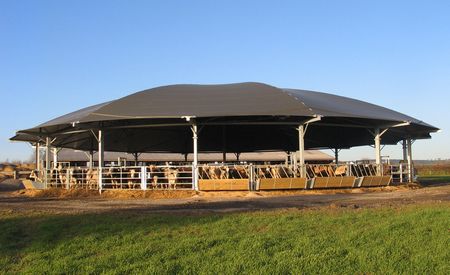Users bear out claims of useful annual savings

With the aim of becoming a one-man system, Roundhouse building designer Geoff Simpson says improving handling and ventilation have been the two driving factors behind his design.
Capable of housing 150 beef cattle and costing about £45,000 – with groundworks, metalwork and other services bringing total expenditure to just under £100,000 – some farmers would question its economical efficiency.
But having gathered performance results from the three producers who initially trialled the building, Mr Simpson has concluded that savings of up to £18,000 a year areachievable on a system based on athroughput of 350 beef cattle a year.
Savings can be made partly due to a predicted 50-75% reduction in vet costs, due to fewer cases of pneumonia. “Superior ventilation also helps to reduce humidity, so cattle remain drier and use 15-30% less straw bedding.
“Users also report that building design has reduced labour input, as well as improved general cattle health. Average finishing times have been two to five weeks shorter, compared with similar cattle breeds in conventional housing,” he says.
“A round building provides fantastic ventilation, because air is channelled naturally through the 10m sq chimney at the top of the roof,” adds Mr Simpson, managing director of Roundhouse Buildings Solutions, Barnard Castle, County Durham.
Mr Simpson, who is looking at the potential of the building for other uses, including housing for a variety of livestock and companion animals, believes the Roundhouse can offer a cost-effective design option. It has also been well received by planning authorities in several counties, he says.
The building comes in one standard size, although additional Roundhouses can be linked to the original, to accommodate extra livestock. With an overall area of 905sq m, housing totals 718sq m, split into eight sections, each about 90sq m.
There are no walls to the building, he says. “A central steel kingpin joins eight roof trusses, held up by 16 perimeter supports. The roof is made from a single piece of tensile, PVC-coated fabric, assembled on the ground and raised using hydraulic rams.”
Capable of accommodating 150 cattle, the recommended stocking density is 4.7sq m for each 450kg animal. Features include a loading bay and circular handling pen in the central area, with animal pens having gate-free access for stockmen.
The roof deflects water into a series of hollow steel uprights connected to the supporting roof structure, channelling the water into a pipe at the bottom of the column for collection or disposal.

Although the £90,000 required for a roundhouse is a significant investment, it is proving its worth in terms of preventing ventilation and reducing finishing period.
Case study Nick Hodgson, Darlington
He is convinced he made the right decision when he invested just under £90,000 in a Roundhouse at The Grange, Darlington. He uses it to house 150 crossbred heifers, which enter the system at one year old and are finished between three and four months later. Having used the Roundhouse for a year, he estimates a reduction in average finishing time of at least a fortnight and requires less labour input. Mr Hodgson, who also houses cattle in a range of rectangular, open-fronted buildings, says he has seen fewer cases of pneumonia in the Roundhouse herd. “If I decide to expand further, I would definitely put up another Roundhouse, because the cattle are more content and, therefore, perform better. I also find animals are easier to manage, which is an important factor. “Adding another traditional building would have cost roughly the same amount of money, but I think this revolutionary design will give a better return on investment in the long-term.” |

 One of the six producers using a Roundhouse, Nick Hodgson reckons it has allowed him to increase cattle throughput by 100 head a year.
One of the six producers using a Roundhouse, Nick Hodgson reckons it has allowed him to increase cattle throughput by 100 head a year.